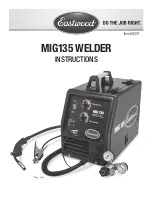
6.
Remove the Contact Tip and Nozzle from the MIG Gun.
7.
Turn on the machine and set the wire speed to about “5”.
8.
With the gun pointed away from you and others, depress the trigger to begin feeding wire.
NOTE:
Watch the drive roller to see if any slipping is occurring be-
tween the roller and the wire – if so turn the machine off and tighten the Pressure Adjuster 1⁄4 turn and test again. Also check Wire Spool Wing Nut tightness.
9.
You do not want to set too much tension on the Pressure Adjuster as it will tend to deform the wire. Just enough to feed the wire without slipping.
10.
Once the wire has emerged from the tip of the MIG Gun, turn the machine OFF and replace the Contact Tip and Nozzle.
CONNECTING THE WELDER TO A POWER SOURCE
The Eastwood MIG135 welder requires a dedicated 120 VAC 20 Amp grounded outlet protected by a breaker. If using an extension cord, use a 12 AWG cord
for up to 50'.
SHIELDING GAS FLOW ADJUSTMENT
After connecting your Shielding Gas Regulator, the gas flow rate needs to be adjusted so that the proper amount of Shielding Gas is flowing over your weld. If
there is too little gas flow there will be porosity in your welds as well as excessive spatter, if there is too much gas flow you will be wasting gas and may affect
the weld quality. The included regulator has 2 gauges on it; the gauge on the left is your flow rate while the gauge on your right is your tank pressure.
11.
Open your Shielding Gas tank valve all the way.
12.
Adjust the knob on the regulator to ~30 CFH.
13.
Turn on the welder and trigger the MIG Gun switch which will start the gas flow.
14.
As you trigger the MIG Gun switch you will notice that as the gas flow starts the needle on the gauge drops to a steady reading.
The reading while flowing is the value you want to read.
15.
The gas flow should be set to ~20 CFH while flowing.
The CFH (Cubic Feet per Hour) scale is the inside scale in red on your flow gauge.
20 CFH is the most typical flow rate but it may need to be adjusted in some cases depending if there is a slight breeze or some other instance where
additional shielding gas is required to prevent porosity in the weld.
16.
When finished welding remember to close the gas valve on the bottle.
CHANGING THE DRIVER ROLLER
The wire feed drive roller on the drive motor has 2 grooves, one for 0.023” (0.6mm) welding wire and another for 0.030” (0.8mm) or 0.035” (0.9mm) welding wire. Your
MIG135 comes with the drive roller installed for using 0.023” (0.6mm) wire. In the event that 0.030” or 0.035” welding wire is to be used, the Drive Roller needs to be changed.
FOR EASTWOOD MIG135 WELDERS WITH KEY WAY STYLE
DRIVER ROLLER (FIG. H)
1.
Unlock the Pressure Adjuster
(FIG. H1)
by pulling it down and towards you.
2.
Lift the Rocker Arm
(FIG. H2)
up and out of the way.
3.
Unthread and remove large center Knob holding the Drive Roller in place
(FIG. H3)
.
4.
Slide the Drive Roller
(FIG. H4)
off the shaft.
5.
Determine which size wire is going to be used and slide the drive roller back onto
the shaft by aligning the key on the shaft with the keyway on the roller.
NOTE:
The
stamped marking on the side of the drive roller indicates the size of the groove on the
opposite side of the roller. The groove closest to the drive motor is the groove that will
be used. If setting up to use 0.023” (0.6mm) wire, the ‘0.6’ stamping should be facing
the machine when installing it.
6.
Tighten the thumb screw on the Drive Roller and lower the Rocker Arm
(FIG. H2)
back into place.
7.
Lift up on the Pressure Adjuster
(FIG. H1)
to put back in place and adjust as necessary.
To order parts and supplies: 800.343.9353 >> eastwood.com
9
FIG. H
✓
H1
H2
H3
✓
ELECTRIC SHOCK HAZARD!
Turn welder off and unplug from electrical outlet before removing or installing
the Drive Roller.
✓
✓
H4
Rotate Up
















